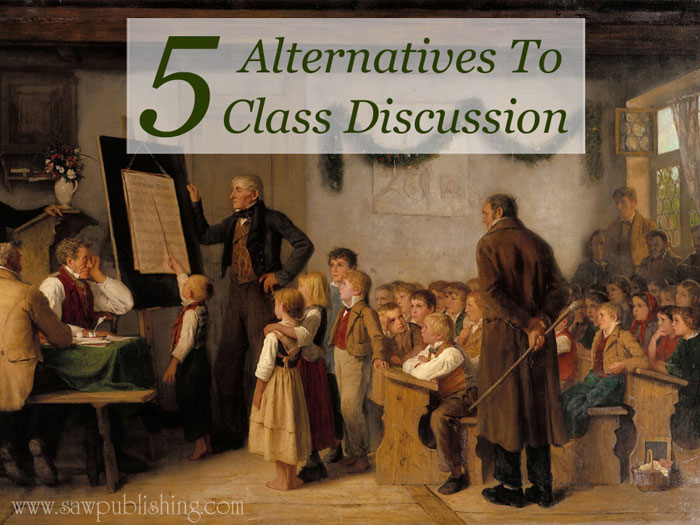5 Great Homeschooling Alternatives to Class Discussions
You’re a conscientious homeschooling mom. You’ve worked faithfully through the textbooks, the assigned reading, the special projects. And now, at the end of lesson five, you come to a roadblock. “Discuss as a Class.”
Help!
It isn’t the topic. The topic is perfect. It isn’t the class … exactly. You have a really good class, that has been excited and engaged every day. But how, how, how, are you going to have a classroom discussion with your grand total of one student?

Class discussions, by their very nature, need some adapting to be used in a homeschool setting. The great thing is that as a mom, as well as a teacher, you have a wonderful opportunity to personalize these seemingly-awkward assignments to fit your student’s needs, your own needs, and the needs of your homeschool as a whole.
What Is The Aim Of Class Discussions?
As I sat down to think about this post, this question occurred to me. If we can pinpoint the aim of a class discussion, we can begin looking at ways to reach that aim in a slightly different way.
The aim of a class discussion is probably twofold. In the first place, it helps students think about their topic. Textbook material can feel distant from everyday life. It’s easy to study a subject without really internalizing it or considering its application personally. Classroom discussions help students to think about and form an opinion on their topic.
In the second place, they allow students to learn to discuss courteously and convincingly. People in a room will have different viewpoints. On some issues, it is good for children to learn to consider another person’s opinion. As a simple example, some people set their tables with all of the silverware on the same side of the plate. Others put the fork on the left, and the knife and spoon on the right. There is no morally correct viewpoint here, they are just two ways of doing the same task.
On the flip side, there are other issues in which we don’t want an open mind. If our classroom discussion is about honesty, we would be compromising to say that everyone’s viewpoint is right. The Bible teaches clearly that dishonesty is sin. (2 Corinthians 4:2)
But in either case, class discussions can allow students to gain skill in listening graciously, and supporting their own point clearly and compellingly.
So, with these aims in mind, what are some alternatives to discussing as a class, which will still encourage students to truly think about their topic and discuss it well?
Alternatives to Class Discussion
1. Family Discussion
This is, in my mind, the all-time best alternative to a classroom discussion! Talk about it as a family. Family is the pillar of homeschooling. Your family is your classroom—not just during school hours, but all the time. Why not have your class discussion around the dinner table? This is a fabulous way to encourage everyone to think about the topic, and to practice discussing it in a courteous, convincing manner.
For some topics, it will be difficult to have a family discussion when the whole family has not studied the lesson material. If you have an older student who took the course in the past, or are in a position to rearrange your schedule so that another child can participate in the specific lesson under discussion, you might consider having that child (or children), join your class for the day, so that you have a few more voices in your discussion. The group will not be quite as large as a traditional classroom, but a smaller group has advantages of its own. Everyone is likely to be more engaged, and to participate in the conversation when there are only a few students in the class.

2. Student Takes Both Sides
When part of the aim is for the student to consider several viewpoints, you may want to choose an activity which encourages the child to look at their topic from multiple sides.
“Compare and Contrast” is a common activity with several variations, that requires students to note the similarities and differences between two topics. It can be presented in bullet points, as a graph, in an essay, etc. It can also be used when you want the student to support only one side, by asking the student to draw a conclusion based on their comparison.
One of my favorite activities for discussing multiple viewpoints came from a history course that was actually from a government curriculum, and was intended for standard classroom use. It was based on an interview format. The students created a list of interview questions, and then came up with two sets of answers to the questions, to represent two different sides of a topic. We video-taped the interviews, while another option was to conduct them live for the rest of the class. Of course, this does take more than one child to perform the interviews, but the questions and answers are written beforehand, and can be done by a single student. Children in other grades are usually happy to lend a hand when it comes to reading them out loud.
Another variation to this concept would be for students to write two letters on the same topic, each expressing a different view. This ties in excellently with literature or history, where you can assign a specific character, or real-life person, from whose perspective the letter is to be written. Writing letters like this can be a lot of fun, as well as an effective educational tool.

3. Student Takes One Side
For situations where you want your student to take only one side of the question and practice supporting their position, there is always the old, tried-and-true persuasive essay. An essay, I freely admit, is not the most exciting of activities. But for building a connected, well-supported argument in defence of a particular point or opinion, it does have its place.
A more engaging variation to the standard essay is a presentation, explaining the topic, and your position on it. This can be created just for the teacher’s benefit, or can be presented to a friend or family member, with the convenience that the receiver doesn’t need to have previous background on the subject.
4. Teacher and Student Discussion
Don’t hesitate to take this simple alternative, either. Most moms learn as much as they teach while homeschooling. A one-on-one discussion between the student and teacher is an easy way to adapt the traditional class discussion, without needing any extra preparation, or juggling of schedules. It also gives you the opportunity to lead the conversation in whatever direction you think will be most beneficial for your particular topic and student—to cover the material that needs the most thought, or has the greatest impact, or any other recommendation you what to take advantage of.

5. When To Skip Class Discussions
And finally, unless your provincial/state regulations require you to complete the activity, don’t forget that it is just an activity. It was directed at the needs of an entire class, but it might not fit in with the needs of your particular student.
The curriculum is provided to help your child internalize a given subject. If one of the activities doesn’t fit in with this aim, it is perfectly acceptable to substitute or cut it!
If your child is already talking about their subject every day at the lunch table, or is discussing the content with thoughtfulness and understanding while you’re reading the lesson—if they are already learning to think about the material they take in, and discuss it courteously and convincingly, then they have probably already reached the goal that a classroom discussion was aiming at. There is a time when it’s just fine to skip a class discussion.
Homeschool moms need more of this kind of permission. Class discussions have their place. Most curriculum activities have a certain value. But they are the servant, not the master. Do what is best for your student and your family, without worrying about performing the curriculum perfectly in the eyes of the world.
“Commit thy works unto the LORD, and thy thoughts shall be established.” – Proverbs 16:3
